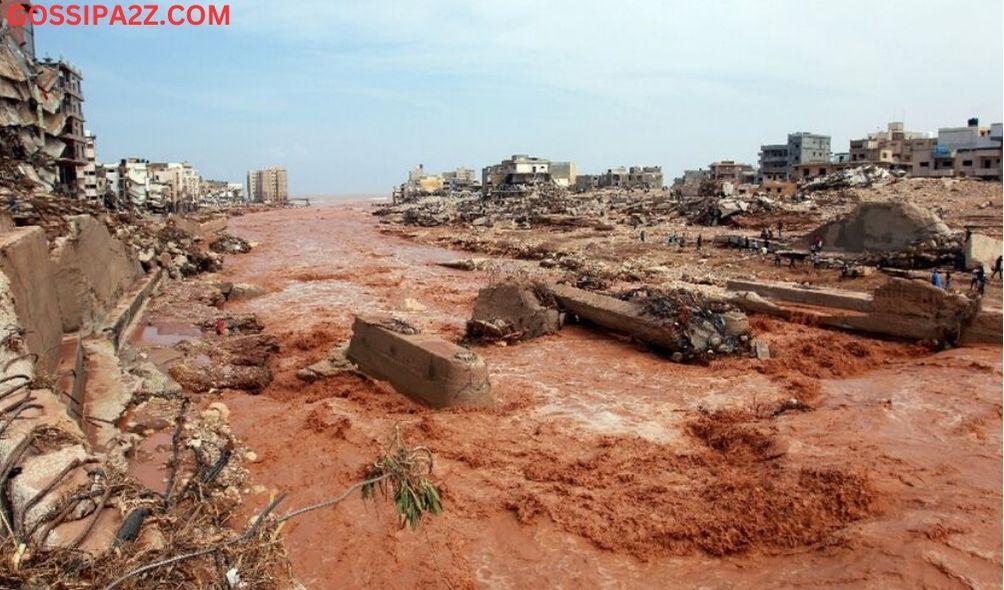At least 2,300 people killed in Libya floods
Flash floods in eastern Libya killed more than 2,300 people in the Mediterranean coastal city of Derna alone, the emergency services of the Tripoli-based government said on Tuesday.
More than 10,000 people remained missing while about 7,000 people were injured by the force of floodwaters that rushed down a normally dry river valley, said Osama Ali, spokesman for the Tripoli-based emergency services, which has had a team in Derna since Monday.
Thousands are feared dead or missing in Libya after huge flash floods devastated eastern regions, with a surge of muddy river water ripping away entire neighborhoods in one coastal city, local authorities and international aid groups said Tuesday.
Massive destruction can be seen in images published online from the port city of Derna, home to 100,000 people, where multi-story buildings on the river banks collapsed and houses vanished in the raging waters after two upstream dams broke.
The disaster in the war-scarred country was caused by torrential rains from Storm Daniel, which made landfall in Libya on Sunday after earlier lashing other Mediterranean countries, especially Greece but also Bulgaria and Turkey.
ALSO READ: Earthquake in Morocco: provisional death toll rises to 1,037
The coastal city of Derna, 250 kilometers west of Benghazi, is ringed by hills and bisected by what is normally a dry riverbed in summer, but which has turned into a raging torrent that also swept away several major bridges.
“The death toll is huge and might reach thousands,” warned Tamer Ramadan of the International Federation of Red Cross and Red Crescent Societies, echoing reports from local leaders who said 2,000 people had died.
“We confirm from our independent sources of information that the number of missing people is hitting 10,000 persons so far,” Ramadan told reporters in Geneva via video link from Tunisia, which borders Libya.
Footage on Libyan TV showed dozens of bodies, wrapped in blankets or sheets, on Derna’s main square, awaiting identification and burial, and more bodies in Martouba, a village about 30 kilometers to the southeast.
More than 300 victims were buried Monday, many in mass graves — but vastly greater numbers of people were feared lost in the waters of the river that empties into the Mediterranean Sea.
‘Catastrophic’ situation
Libya, an oil-rich country in North Africa, is still recovering from the years of war and chaos that followed the 2011 NATO-backed popular uprising which toppled and killed longtime dictator Moamer Kadhafi.
The country is now divided between two rival governments — the UN-brokered, internationally recognized administration based in the capital Tripoli in the west, and a separate administration in the eastern region impacted by the flood disaster.
Access to the eastern region is limited, and phone and online links have been largely severed, but the administration’s prime minister Oussama Hamad has reported “more than 2,000 dead and thousands missing” in Derna alone.
The military strongman backing the eastern administration, Khalifa Haftar, issued a similar warning, though the toll had yet to be confirmed by emergency or medical services.
A Derna city council official described the situation as “catastrophic” and asked for a “national and international intervention”, speaking to the TV channel Libya al-Ahrar.
Rescue teams from Turkey have arrived in eastern Libya, according to authorities, and the UN and several countries offered to send aid, among them the United States, Italy, France, Qatar, Egypt, and Tunisia.
‘Harrowing images’
The storm also hit Benghazi and the hill district of Jabal al-Akhdar, and flooding, mudslides, and other major damage were reported from the wider region, with images showing overturned cars and trucks.
Libya’s National Petroleum Company, which has its main fields and terminals in eastern Libya, declared “a state of maximum alert” and suspended flights between production sites where it said activity was drastically reduced.
Libya’s UN-brokered government under Abdelhamid Dbeibah announced three days of national mourning on Monday and emphasized “the unity of all Libyans” in the face of the disaster.
Aid convoys from Tripoli were heading east and Dbeibah’s government announced the dispatch of two ambulance planes and a helicopter, as well as rescue teams, canine search squads, and 87 doctors, as well as technicians to restore power. The alarm has spread globally, with many foreign leaders voicing their condolences.
European Council president Charles Michel, writing on X, formerly Twitter, noted the “harrowing images from Libya following deaths & destruction caused by floods, especially in the east … EU stands ready to help those affected by this calamity.”
US State Department spokesperson Matthew Miller also offered “sympathies and condolences” to those affected and said Washington was working with the UN and Libyan authorities to help relief efforts.
At least 2,300 people killed in Libya floods
